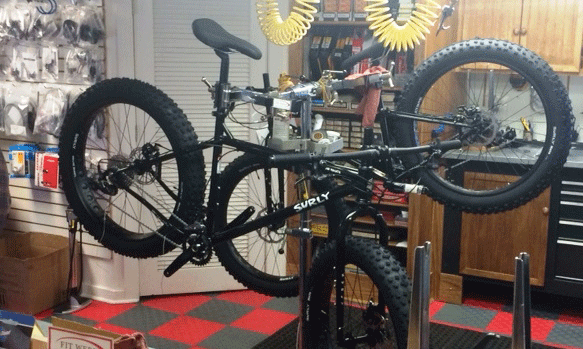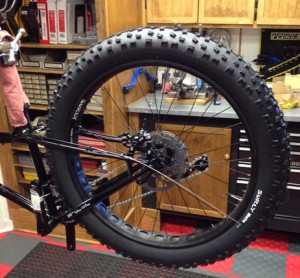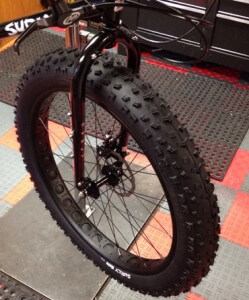Surly Pugsley Fat Bike Review and Overview
By Jim Weaver
Service Manager, Fit Werx, Waitsfield, VT
Who said that Fit Werx is only about road and tri bikes? In addition to our cyclocross, gravel road and mountain bike options, we work with fat bikes too – the hottest thing in cold biking.
Fat bikes were born out of the extreme Iditabike race in Alaska, and were designed for riding in the snow. The original fat bikes actually probably came out over twenty years ago when Iditabike participants were building one-off bikes where they would strap two rims together to allow for super wide tire options. Interestingly, we had a client from Key West in for a fitting, and she asked why we had such a bike here. In Florida, fat bikes are used all the time to ride on the beach. Snow or sand, these bikes can handle the task. We just received two fat bikes, from Surly, and I thought I would write a quick note about the Surly Pugsley (a great name!), along with a few pictures taken during the build process.
In explaining fat bikes to my wife, I said that they are like a mountain bike on steroids. Fat bikes are the monster trucks of the bicycle world. On the surface, the frame, and much of the drivetrain, of a fat bike looks like a hardtail mountain bike. Closer examination, however, would lead you to think that, gee, that fork is awfully wide, as is the rear triangle. Why? Well, look at those tires! Whoa! That’s what I mean by a bike on steroids. The stock tires on the Surly Pug sley are 4.0″ and this is actually on the narrower side of what is available; depending on the design of the bike, you can mount tires close to 5″ wide. The tire width is why these bikes work in the snow, or if you head to the beach, in the sand. As our Key West client’s child said, the tires are like snowshoes for a bike. Exactly. Needless to say, a tire this wide will work far better in snow than the usual mountain bike tire that is half its width. These bikes are designed around the tires and equipped for the slower riding conditions that will be encountered riding on such soft or uneven surfaces.
sley are 4.0″ and this is actually on the narrower side of what is available; depending on the design of the bike, you can mount tires close to 5″ wide. The tire width is why these bikes work in the snow, or if you head to the beach, in the sand. As our Key West client’s child said, the tires are like snowshoes for a bike. Exactly. Needless to say, a tire this wide will work far better in snow than the usual mountain bike tire that is half its width. These bikes are designed around the tires and equipped for the slower riding conditions that will be encountered riding on such soft or uneven surfaces.
The Surly Pugsley is the original mass produced fat bike and runs $1750. The frame and fork of the Pugsley is 4130 chromoly, and the tubing on the main triangle is double butted. The 2×10 drivetrain is a mix of solid mid-level mountain bike components. The derailleurs are Shimano Deore. Deore components, have always been functional, sturdy, and reliable performers. Given the cost of this bike, and the expected use, these were a good choice. The shifter, indexed thumb shifters, look a bit old school at first blush, but there is a functional reason for the thumb shifters as they allow you to shift even when wearing heavy mittens, something that trigger or twist shifters would not do nearly as well. The brakes are Avid BB7 cable-actuated discs. Again, not the top of SRAM’s line, but like the shifters, reliable and functional, and providing ample braking performance. The rear rotor is 160 mm, the front 180 mm. Finally, the crankset is SRAM X5, equipped with a low gearing combination of 22/36. The Shimano rear cassette is 10 speed, with a range of 11/36. The resulting gearing combinations are ideal for riding in snow or sand, where you cannot really expect to need to achieve speeds of 15 mph or more. A general rule I have heard is that your average speed on a fat bike with be about 1/3 of your average speed on the road. Even if ridden on the road, with the tires pumped to maximum recommendation inflation of 30 psi (on snow pressures can range below 4 psi, with 10-15 psi being average!), getting up to a speed where you will spin out 36/11 gearing is unlikely. So, that high gear combination should be more than adequate, while that 22/36 low gear will frequently find use on hills and deeper snow. Again, fat bikes are not about speed.
 Understandably, fat bikes may not be svelte. The Pugsley weighed in at 15.35 ……. kilograms. This means 33 pounds 13 ounces. While the steel frame is not as light as some of the higher end aluminum and carbon options from brands like Fatback, the majority of the weight is in the wheels and tires. The front wheel, with the tire mounted, weighed in at 7 pounds 12 ounces, while the rear, with cassette installed, is just over 9 pounds – the wheels alone are heavier than many complete road bikes. Lighter weight fat bikes are available, with carbon frames, carbon fiber wheels, tubeless tires, carbon bars and stem, etc., and bikes in the low 20 pound range are possible. They are not $1750 though.
Understandably, fat bikes may not be svelte. The Pugsley weighed in at 15.35 ……. kilograms. This means 33 pounds 13 ounces. While the steel frame is not as light as some of the higher end aluminum and carbon options from brands like Fatback, the majority of the weight is in the wheels and tires. The front wheel, with the tire mounted, weighed in at 7 pounds 12 ounces, while the rear, with cassette installed, is just over 9 pounds – the wheels alone are heavier than many complete road bikes. Lighter weight fat bikes are available, with carbon frames, carbon fiber wheels, tubeless tires, carbon bars and stem, etc., and bikes in the low 20 pound range are possible. They are not $1750 though.
For many fat bike riders, bike weight is not the point. Fat bikes are a different kind of animal from road, cross or mountain bikes. The point of these bikes is to be able to ride all year around, even when the conditions outside discourage riding a road, or even a cross, bike. You can ride a fat bike on the road with impunity boarding on arrogance, confident that the gravel roads, snow, cinders, salt, and other debris will be at worst a minor annoyance. You still should use a bit of caution on ice though… Also, you can turn onto a snow covered trail and go exploring as long as you have a reasonably firm base. In Vermont, this means you can get a VAST trail pass and get out on those snowmobile trails that crisscross the state. So, bundle up, put on those mittens, maybe pull on that balaclava, don your ski goggles, get those winter cycling shoes, and get on a fat bike!
Fat tires or skinny, bikes shouldn’t be a commodity and a bike purchased at “Shop A” is not necessarily the same as “Shop B” in terms of fit, finish, spec or assembly. Fit Werx is here to help you end up on a bike that not only fits you well, but also is built properly and allows you to have the best long-term ownership experience as possible. Fat bike or skinny bike, if you want great long-term value, check out Fit Werx for your next bike with locations outside NYC in Bergen County, NJ; Peabody and Lexington (spring ’15), MA and near Stowe and Burlington, VT (Waitsfield).
